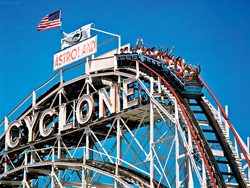Vol. 232 No. 9
Don’t look down!
|
.jpg)
|
Click … click … click. The roller coaster clatters to the top just before it plunges, making you scream out loud and feel a tight knot in your stomach. That’s what I remember from riding the Texas Cyclone roller coaster in Houston’s Astroworld about 40 years ago. I haven’t ridden any roller coasters since, but the feeling is not much different from riding up and down the oil and gas economic roller coaster.
 |
| The original Cyclone roller coaster on Coney Island, New York is still standing after Hurricane Irene. Houston’s Texas Cyclone closed down in January 2005. |
|
Right now, the oil industry is perched at the top of the roller coaster. Most of the oil companies and service companies have reported record second quarter revenues as a result of high oil prices. The US and international rig counts are still rising. The world looks magnificent from the top, but don’t look down! There are disquieting signs on the horizon that threaten to send us barreling downward. Energy analyst Carl Larry, director of energy derivatives and research with Blue Ocean Brokerage in New York, is fond of saying that the fundamentals for the industry are strong. Other analysts even suggest that this time it’s different—the demand will be so strong from the emerging countries that oil prices will continue to spiral upward. Nevertheless, here are some trends worth considering.
The fortunes of our industry are tied explicitly to oil and gas prices. Since then, however, oil prices have climbed steadily in anticipation of a worldwide recovery. As a result, many of the operators have switched to oil and liquids-directed drilling.
No one has yet come up with a precise mathematical formulation for the market price of oil. The gap between the demand and supply is the main variable. But other factors include the exchange value of the US dollar, commodity speculation and the market’s perception of the future expectations of demand and supply.
On the supply side, production is proceeding at full throttle from both OPEC and non-OPEC countries to take advantage of the high oil prices. Declining production from mature fields and the loss of production from the Gulf of Mexico should be overcome by the return of Libyan oil, revived production from the oil fields in Iraq, presalt Brazil, enhanced recovery efforts in Saudi Arabia and the North Sea, and unconventional sources, including shale and Canadian oil sands. Over the next decade, the Gulf of Mexico should be back in play and, hopefully, production will begin from frontier areas such as the Arctic.
It’s the demand side that is worrisome. Oil prices have already dropped from upwards of $100 to the mid-$80s within the last quarter due to worries about Europe’s sovereign debt crisis, wrangling over the debt ceiling in the US and the threat of a double-dip recession. The question is how quickly the world economy will recover to shore up the demand. The PIIGS countries (Portugal, Italy, Ireland, Greece and Spain) are struggling with sovereign debt and the UK is trying to pull out of recession through a 20% value-added tax and cuts in social services.
The United States is engaged in a battle royale on cutting costs and raising revenues in the face of a $14.3 trillion national debt, $1.4 trillion budget and 9.1% unemployment. These may be precursors of a double-dip recessionary slowdown. Exporters such as China and Southeast Asia are dependent on consumer demand in Europe and North America. As a consequence, our oil and gas roller coaster could be headed for a downturn. It would be prudent to grip the bar tightly and hope for the best.
|

.jpg)


